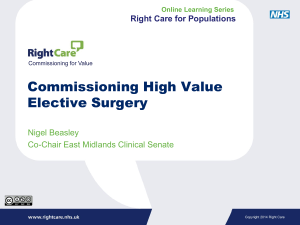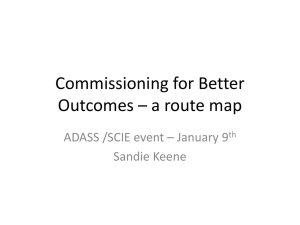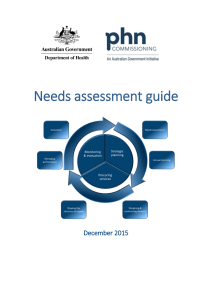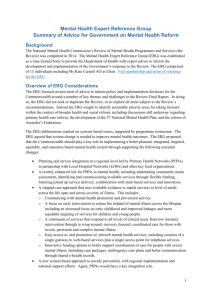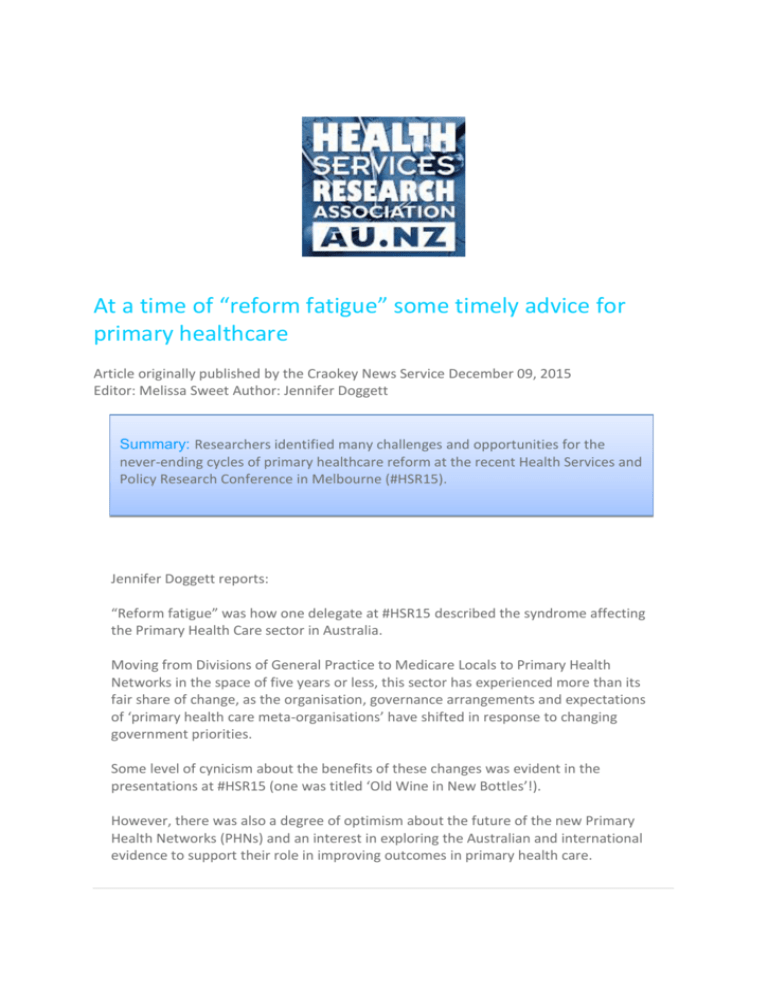
At a time of “reform fatigue” some timely advice for
primary healthcare
Article originally published by the Craokey News Service December 09, 2015
Editor: Melissa Sweet Author: Jennifer Doggett
Summary: Researchers identified many challenges and opportunities for the
never-ending cycles of primary healthcare reform at the recent Health Services and
Policy Research Conference in Melbourne (#HSR15).
Jennifer Doggett reports:
.
“Reform fatigue” was how one delegate at #HSR15 described the syndrome affecting
the Primary Health Care sector in Australia.
Moving from Divisions of General Practice to Medicare Locals to Primary Health
Networks in the space of five years or less, this sector has experienced more than its
fair share of change, as the organisation, governance arrangements and expectations
of ‘primary health care meta-organisations’ have shifted in response to changing
government priorities.
Some level of cynicism about the benefits of these changes was evident in the
presentations at #HSR15 (one was titled ‘Old Wine in New Bottles’!).
However, there was also a degree of optimism about the future of the new Primary
Health Networks (PHNs) and an interest in exploring the Australian and international
evidence to support their role in improving outcomes in primary health care.
One popular session focused on PHN governance arrangements and
provided a number of different perspectives on how these new
organisations could benefit from the findings of recent research in
this area.
Secrets to successful commissioning
Coming from the UK, Associate Professor Helen Dickinson of the
University of Melbourne has extensive direct experience of the commissioning role of
primary health care organisations in the National Health Service. She gave a
presentation drawing on her UK-based experience and research, which focused on the
role that these new organisations will have in commissioning health services.
Dickinson noted that unlike Medicare Locals and their predecessors (Divisions of
General Practice), PHNs have been given an explicit commissioning role, with the goal
of improving service efficiency and effectiveness, as well as improving coordination of
care in particular for groups at risk of poor health outcomes.
She argued that in order to achieve these aims, PHNs will require a sound
understanding of their role in commissioning health services and also the required
knowledge and skills to undertake this role. Her international research into this issue
suggests that there are no simple guidelines for commissioning in the health sector, a
process that she described as ‘challenging’ and as ‘more art than science’.
One reason for the lack of clarity around the commissioning role was that the concept
itself is often not clearly defined and often has different meanings for different
stakeholders. Her current research with PHNs and stakeholders has found that this
lack of clarity also exists within the Australian health sector. She argued that unless
this is resolved it could result in confusion between and among PHNs and government
about their roles and aims.
Dickinson recommended that agreeing on the precise definition of commissioning
should be a first step, along with ensuring that the relevant PHN staff have the training
and experience required to deal with the technical aspects of commissioning, such as
contract management.
However, she also stressed the importance of not letting ‘process issues’ dominate
and for PHNs to ensure they also focus on building strong relationships with providers.
Integrating care
The next presenter at this session, Dr Bernadette Ward from Monash University, also
spoke about integrated primary health care in the context of a constantly changing
primary health care sector.
Her presentation focused on a study on improving access to care undertaken by a
team of researchers across NSW, Victoria and South Australia,
including Dr Christine Walker from the Chronic Illness Alliance.
The research involved a comparative case study of six integrated
primary health care centres in NSW and Victoria and included a
range of models such as GP Super Clinics, community health
centres and traditional GP practices. A major aim of this project
was to identify the factors that have the greatest influence on
the performance of this type of health service.
The research included looking at a range of elements of access, including availability,
accommodation, approachability, affordability, acceptability and appropriateness.
Ward reported that the study found significant variability between the models, and
that these were influenced significantly by organisational and contextual factors, such
as contractual arrangements, governance arrangements and GP supply.
Ward used these findings to demonstrate how policies can be developed to influence
these factors and therefore support increased access. These could include increasing
the supply of GPs in areas of need, supporting bulkbilling and including specific access
requirements in contracts.
She also made the point that while there is extensive research demonstrating the
benefits of high quality integrated primary healthcare for both identifying and treating
chronic conditions, there is much less literature on how health services can achieve
this aim.
She argued for the need for more research into this issue in the Australian context in
order to support PHNs to achieve their aim of improving access to care.
Cross-sectoral leadership required
Caroline Nicholson, Director of the Mater/UQ Centre for Primary Health Care
Innovation, also reported on research she had undertaken on integrated primary and
secondary health care governance, in conjunction with a group of colleagues,
including past RACGP President Professor Claire Jackson.
She argued that the primary and secondary health care sectors need to be better
integrated if the goals of health reform – such as improving outcomes for people with
complex and chronic illness – are to be realised. This requires leadership from both
sectors and her research focused on the views of board members and CEOs of PHNs as
to how this can be achieved.
This project identified ten elements of successful primary/secondary care integration,
including shared clinical priorities, joint planning, effective change management,
integrated information systems and consumer engagement.
Her assessment of progress against these elements in the current reform environment
was that while gains had been achieved in some areas, for example, in consumer
engagement, there were other areas in which little progress had been made, such as
in change management and integrated information systems. She argued that unless
these areas were addressed they could undermine the capacity of the reforms to
successfully achieve integrated care.
Some additional tips for those working in the primary health care sector came in the
closing plenary session of the conference, with two of the visiting US experts reflecting
on the main themes of the conference and providing some advice on future directions
for HSR.
Equity matters
Dr Amal Trivedi from Brown University in the US noted that
equity was a running theme of the conference, encompassing
equity between different population groups, geographical areas
and socio-economic levels.
He said it had become clear over the three days of the conference
that it was impossible to evaluate quality or outcomes without
also considering equity. This approach he described as ‘third
generation’ equity studies, where equity is integrated into all aspects of a health
service and program and considered in its broadest sense, as defined by consumers
and the community (rather than by providers or managers).
He also described stakeholder engagement in Australia as more advanced than in the
US, and specifically mentioned the multiple ways in which stakeholders are involved in
health service planning, delivery and evaluation as a key strength of our health
system.
In terms of a future direction for health services research in Australia, he highlighted
the comments from patient advocate and consumer Jen Morris who described
consumers as “the most under-utilised resource in the health system”, and supported
her call for increased consumer input into health service delivery.
In her closing comments, Professor Sherry Glied, from New York University, reflected
on three aspects of Australian culture that impressed her during her visit: the high
Australian minimum wage (in comparison with that in the USA); the efficient public
transport system (in Melbourne); and the respect shown to Aboriginal and Torres
Strait Islander people.
While she did not elaborate on the health impacts of her observations, it is interesting
to note that all three of these factors have significant implications for population
health.
Importance of relationships
Glied also described a number of challenges in the Australian health system – in
particular, she said it was tough to manage a system in which there were divisions in
the responsibility for health care, for example Federal/State and public/private, with
multiple points of interaction and a lack of transparency around funding
arrangements.
She noted that this complexity can result in both gaps and duplication in services, and
also uncertainty for consumers.
Her parting advice for health service researchers in Australia was to make the most of
the data that is available to them. While it might be frustrating not to be able to use
data that is being collected, she advised that there is often a great deal that can be
achieved through de-identified and aggregate data.
In terms of dealing with governments, she reiterated her opening keynote address in
encouraging researchers to be more pro-active in working with governments.
Glied advised researchers to develop relationships with bureaucrats and to listen to
their priorities and concerns, saying that “it’s impossible to come up with the answers
that governments need unless you know the questions that are being asked.”
Copyright © 2015 *|HSRAANZ|*, All rights reserved.
For more information:
Sarah Green
Executive Officer, HSRAANZ
C/o CHERE,
Faculty of Business, UTS
PO Box 123
Broadway,
NSW, 2007
Tel; 02 9514 4723
Email: sarah.green@chere.uts.edu.au

